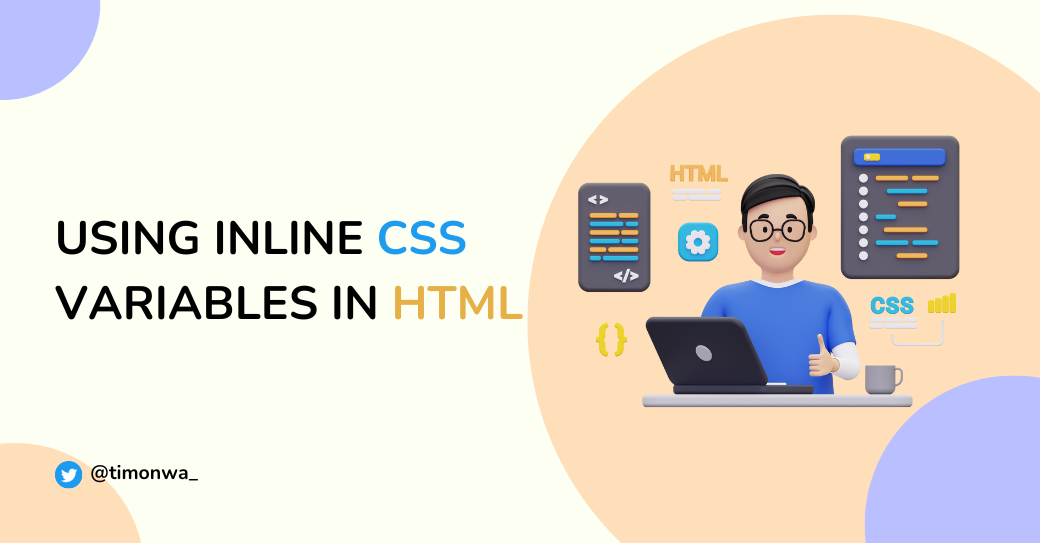How to use Inline CSS Variable in Html
Posted on: Feb 15, 2024
5 mins read

CSS variables, known as custom properties, are a handy tool for managing and reusing styles in web projects. Technically used in stylesheets, they can also be applied directly within HTML for more dynamic and flexible styling. If you're new to CSS variables, check out my article on how to use CSS variables like a pro.
Understanding Inline CSS
Inline CSS is the process that involves adding CSS styles directly to an HTML element using the style attribute. Here's a simple example:
html<p style="color: red;">This is a paragraph.</p>
This technique comes in handy when you want to add dynamic styling via JavaScript or style a single element without affecting others, avoiding the need for a separate stylesheet.
What are Inline CSS Variables?
Inline CSS variables are simply CSS variables used directly within the style attribute of an HTML element. This approach offers a dynamic and isolated method for styling.
How to Use CSS Variables Inline
To apply CSS variables inline in HTML, set the style attribute of an HTML element directly. For instance:
html<div><p>This is a paragraph.</p><p style="--primary-color: goldenrod;">The is a paragraph styled using inline CSS variable.</p><p style="--primary-color: lightgreen;">The is another paragraph styled using inline CSS variable.</p></div>
cssp {color: var(--primary-color);}
In this demo, the style attribute of the second <p> element sets the --primary-color variable to goldenrod. The CSS variable is then used to style the text color of the paragraph.
Why Use CSS Variables Inline?
Although CSS variables are typically used in stylesheets, integrating them inline in HTML offers several advantages:
Dynamic Styling: Imagine you have a weather app that displays temperature with color-coded indicators. You can use inline CSS variables to dynamically adjust the background color of a temperature display based on the temperature range:
html<div class="temperature" style="--bg-color: var(--cold);">10°C</div>js<script>const temperatureElement = document.querySelector(".temperature");const temperature = 10;if (temperature < 0) {temperatureElement.style.setProperty("--bg-color", "var(--freezing)");} else if (temperature > 30) {temperatureElement.style.setProperty("--bg-color", "var(--hot)");} else {temperatureElement.style.setProperty("--bg-color", "var(--moderate)");}</script>Here, the
--bg-colorvariable dynamically represents the temperature's severity level.Isolated Components: Consider a scenario where you have a modular card component used in different sections of your website. Users can customize each card's background color independently without affecting others:
html<div class="card" style="--card-bg-color: #f0f0f0;"><p>This is a customizable card.</p></div><div class="card" style="--card-bg-color: #ffeecc;"><p>Another customizable card.</p></div>In this way, users can tailor the appearance of each card individually.
Inline Styles: Suppose you're creating a blog where authors can highlight specific paragraphs with different background colors. Inline CSS variables provide a cleaner approach for managing these inline styles:
html<div class="highlight" style="--bg-color: #ffeb3b;"><p>This paragraph is highlighted for emphasis.</p></div>Authors can easily adjust the
--bg-colorvariable to customize the highlight color for different paragraphs.
Enjoying this article?
Be the first to read new content, and more!
Occasional emails. No spam. Unsubscribe anytime.
Conclusion
Now that you know about inline CSS variables, feel free to use them in your HTML for dynamic and personalized styling. It's a handy tool that adds simplicity to your styling toolkit. Give it a try and enjoy the flexibility it brings to your web projects! Till next time, byeee!

Image from
giphy.com
Connect With Me
Follow me on X(Twitter), and LinkedIn to stay updated with my latest content.
If you like my notes and want to support me, you can sponsor me on GitHub Sponsor, or you can buy me a virtual ice cream on ByMeACoffee or Selar. I would really appreciate it. 🙏
For other ways to support me, visit my Sponsorship page or Affiliate Links page.
Frequently Asked Questions
1. Can I use CSS variables inline?
Yes, you can use CSS variables inline in your HTML by applying them directly in the style attribute of an HTML element.
2. What is inline CSS with example?
Inline CSS involves adding CSS styles directly to an HTML element using the style attribute. For example: <p style="color: red;">This is a paragraph.</p>
3. What is a CSS variable in HTML?
A CSS variable in HTML, also known as a custom property, is a user-defined entity that stores values for reuse throughout the HTML document. It begins with two hyphens (--). Learn more about CSS variables in my article on using CSS variables like a pro.
4. How do you use inline variables in CSS react?
In React, you can use inline CSS variables by setting the style attribute directly in your JSX components. Here's an example: <div style={{ "--primary-color": "blue" }}>
{/* Your component content */}
</div>
5. Can I set variables in CSS?
Yes, you can set variables in CSS using the `--` syntax. For example: :root {
--primary-color: blue;
}
6. How to use CSS variable in style?
To use a CSS variable in a style, you can apply it using the var()
p {
color: var(--primary-color);
}
7. Why would you use inline CSS?
Inline CSS is useful when you want to apply styles to a single element without affecting others or when you don't want to create a separate stylesheet for a specific element.
8. What is a CSS variable inline?
A CSS variable inline refers to using custom properties directly in the style attribute of an HTML element, providing a dynamic and isolated approach to styling.
9. What are the benefits of using CSS variables?
CSS variables offer benefits such as easy maintenance, reusability, and dynamic styling, enhancing the overall flexibility of your stylesheets.
10. What is inline CSS advantages and disadvantages?
Advantages of inline CSS include simplicity and specific element styling. Disadvantages may include less maintainability and difficulty in managing styles across multiple elements.

